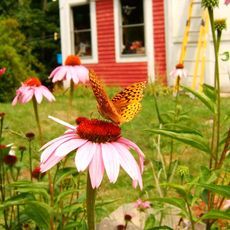Passion Flower Not Fruiting: Why Passion Vine Flowers But Has No Fruit


Passion fruit is a tropical to subtropical vine that bears juicy, aromatic, and sweet to acidic fruit. While the vine prefers a frost-free climate, there are some cultivars tolerant of temperatures into the upper 20’s. If you have a frost tolerant varietal, why then is your passionflower not fruiting? Read on to find out how to get a passionflower to fruit and information of other passionflower vine problems.
Help, No Fruit on Passion Vine!
Passion fruit varies in color from purple to a yellow-orange. The purple passion fruit is much more sensitive to cold temperatures than its yellow counterpart, as well as more susceptible to soil diseases. Although sweeter than yellow passion fruit, it is far more likely to be affected by disease or cold temps that result in no fruit on the passion flower vine. So, the cultivar that you selected to grow may be directly related to why your passion flower is not fruiting.
How to Get a Passion Flower to Fruit
If you have planted a more resilient yellow passion vine not damaged by cold temperatures or disease, there are other reasons for a passion fruit that won’t produce.
Fertilizer
A heavy hand when fertilizing may result in lush green foliage, but flowers that never become fruit. All the energy of the plant is going into producing the abundant foliage and not into fruit production. You only need to fertilize the passion vine twice a year. Once in the early spring after pruning the vine and again in the fall once fruiting is done. Application of rich compost around the vine may also “over” fertilize the plant. Planting sites near septic tanks or compost areas where the vine may access additional nutrients can have the same result.
Poor pollination
The first thing to know regarding a passion flower that is not fruiting is that most varieties are self-sterile and, thus, need a little help pollinating. Many flowers of the purple passion vine will set fruit when self-pollinated, but yellow passion vines need to be pollinated by a different vine that is genetically compatible. If you are experiencing no fruit on your passionflower vine, another reason may be few bee visitors. Bees are needed to cross-pollinate passion fruit flowers in order for fruit to form. Attract more bees by planting aromatic, flowering herbs, like lavender, or other flowering perennials or annuals known to entice them. Honeybees are effective for some small varieties, but the carpenter bee is the most avid pollinator for most passion vine cultivars. Similar in appearance to the bumble bee, carpenter bees can be encouraged to visit your passionflower vine by placing hollow logs near the plants. You can also hand pollinate the passion blossoms yourself. Use a delicate brush or cotton swab and pick a flower and transfer the pollen, gently, from one blossom to another. Hand pollinate in the morning to midmorning.
Reducing Non-Blooming/Fruiting Passion Flower Problems
- While passion fruit vines do not require pruning, it may be beneficial. Pruning of passion vine allows the sun to penetrate through the vine, aiding in ripening fruit. It also produces strong new growth that encourages fruit set. Flowers and fruit do not form on the old growth of a passion flower vine, so if you desire fruit, you need to prune. Prune back the plant at the start of spring. Follow a stem carefully prior to cutting to ensure you are not cutting a major branch.
- Insufficient water will stress the passion vine out, causing it to abort or not even flower. Keep the passion vine moist on a consistent basis. Mulch around the plant to retain moisture but be sure not to overwater, which can further disease.
- Too little fertilizer will also affect a passion vine, causing yellow leaves and lack of fruit set. Passion vines are vigorous growers, so feed the plant 10-5-20 NPK food at the rate of 3 pounds (1 kg.) per plant, a couple times per year or as needed.
- If the plant has been damaged by frost, give it an extra bit of fertilizer once the weather has warmed and the growing season is imminent.
- Pest infested plants become stressed plants which affect fruit set. If the vine becomes infested by ants or aphids, try spraying the plant with Pyrethrum to eradicate the pests.
- Passion fruit likes full sun near the coast, but should be protected from hot, dry, inland heat. It thrives in temperatures from 68 to 82 degrees F. (20-27 C.) in well-draining sandy loam with a pH of between 6.5 and 7. The roots are shallow, so planting in raised beds can increase drainage, which helps thwart soil diseases.
Hopefully, if you are adhering to all of the above, your passion flower will set fruit, but if not, it is still an interesting addition to the home garden and enjoyable for its unique and beautiful blooms.
Gardening tips, videos, info and more delivered right to your inbox!
Sign up for the Gardening Know How newsletter today and receive a free download of our most popular eBook "How to Grow Delicious Tomatoes."

Amy Grant has been gardening for 30 years and writing for 15. A professional chef and caterer, Amy's area of expertise is culinary gardening.
-
 Turn Your Yard Into A Wildlife Habitat: 10 Easy Ways To Make A Wildlife Sanctuary
Turn Your Yard Into A Wildlife Habitat: 10 Easy Ways To Make A Wildlife SanctuaryYou may be dreaming about ways to turn your yard into a wildlife habitat. We say, follow your dreams!
By Teo Spengler
-
 Gardening Makes You Live Longer, According To Research – How To Reap The Benefits
Gardening Makes You Live Longer, According To Research – How To Reap The BenefitsIt's obvious that gardening makes you live longer, but it’s nice to know research supports the idea.
By Mary Ellen Ellis